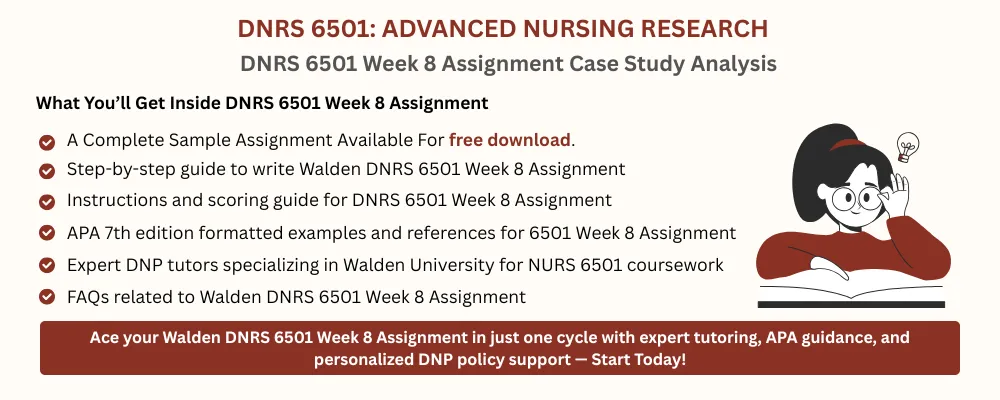DNRS 6501 Week 8 Assignment FREE DOWNLOAD
DNRS 6501 Week 8 Assignment
Case Study Analysis
Student Name
Walden University
DNRS 6501: Advanced Nursing Research
Professor Name
Date
Case Study
The patient, who is a 44-year-old male, has shown symptoms that include acute swelling and pain along with redness in the left knee, followed by pain in his toes and difficulty with weight carrying. He maintains a history of alcohol use along with obesity (BMI 32), hypertension treated with Hydrochlorothiazide, and his work requires physical demands. Medical tests detect elevations in uric acid, ESR, and CRP values and confirm monosodium urate (MSU) crystals present in synovial fluid. The identified findings demonstrate that an inflammatory arthritis condition known as gout is currently active.
Key Symptoms Supporting Diagnosis
Multiple signs and test results indicate the presence of gout as an active condition:
- Intense, sudden joint pain affects both the knees and toes since these areas constitute typical gout target sites.
- Signs of joint swelling and redness indicate inflammation of the affected joints.
- There is no ability to stand or walk because of the extreme pain in the affected joints.
- MSU crystals discovered in synovial fluid serve as the definitive sign for gout.
- The patient’s serum uric acid measured at 8 mg/dL exceeded the normal range, which extends from 3.5–7.2 mg/dL.
- Active inflammation exists based on elevated inflammatory markers, which show ESR at 65 mm/hr and CRP at 10.5 mg/dL (Murdoch et al., 2021).
The observed data, together with the patient’s lifestyle characteristics and medical conditions, support gout as the primary diagnosis.
Musculoskeletal Pathophysiologic Processes
When hyperuricemia exists for a prolonged period, the joint tissues absorb monosodium urate crystals, leading to gout development. The inflammatory response caused by these crystals depends heavily on immune cells, especially neutrophils, to occur (Mgs Irsan Saleh et al., 2023). Because of its role in weight-bearing activities, the knee joint tends to become affected.
Urate crystals cause the activation of the NLRP3 inflammation pathway after local macrophages phagocytose them. The pro-inflammatory cytokine interleukin-1β (IL-1β) gets released from this process while attracting more immune cells that generate the observable signs of inflammation through pain and redness, and swelling. The inflammatory process triggers synovitis together with effusion, which restricts joint movements, leading to intense pain (Mgs Irsan Saleh et al., 2023).
Role of Obesity in Gout and Osteoarthritis Progression
The presence of excess body weight affects how both gout and osteoarthritis develop. Adipose tissue functions as an endocrine organ that produces inflammatory cytokines TNF-α and IL-6, which boost bodywide inflammation and enhance uric acid production. Obesity causes kidney problems that make the body hold onto more uric acid and reduce insulin resistance, which raises uric acid levels in the blood (Katarzyna Mączka et al., 2024). The patient’s BMI of 32 makes him obese, which worsens both his gout attacks and joint degeneration problems.
Certain Factors Determine the Risk of Gout Developing
Different changeable and unchangeable factors combined to create the patient’s gout condition.
Diet and Alcohol Consumption
Regular beer drinking produces uric acid from the purines present in alcoholic drinks. The four beers the patient drank before symptoms started most likely caused his gout attack to happen suddenly.
Obesity
Obesity creates both excess uric acid in the body and joint pressure, which raises the patient’s risk of developing both gout and osteoarthritis (Asghari et al., 2024).
Hypertension and Diuretics
The patient takes Hydrochlorothiazide to control his hypertension, but also as a diuretic medicine. Thiazides decrease the amount of uric acid that leaves the kidneys, which causes increased levels of uric acid in the body.
Occupational Risk
The patient’s floor installation work puts heavy pressure on his joints, which may start gout flares and damage his knees over time.
Male Gender and Age
Men between middle age and older experience more gout because their hormones affect uric acid processing, and their kidneys work less well as they age (Asghari et al., 2024).
Conclusion
The medical signs of joint pain, swelling, and redness, plus higher uric acid levels and inflammation, show that a patient has acute gout. The body experiences two effects when urate crystals deposit during a strong immune response. Obesity creates two problems for joints because it both raises uric acid levels and puts physical pressure on joints, which leads to both gout and osteoarthritis. The patient’s health problem gets worse because of extra risk elements that include drinking alcohol and using diuretics at work. A complete treatment plan includes managing symptoms plus adjusting life habits and medicine use to lower the risk of future attacks and joint harm.
Struggling with DNRS 6501 Week 4 Assignment? Download ready-to-use Case Study Analysis help today!
Instructions To Write DNRS 6501 Week 8 Assignment
Need instructions for this assessment? Contact us now and get expert guidance right away!
Instructions File For 6501 Week 8 Assignment
CASE STUDY ANALYSIS
An understanding of the musculoskeletal systems is a critically important component of disease and disorder diagnosis and treatment. This importance is magnified by the impact that that this system may have on another. A variety of factors and circumstances affecting the emergence and severity of issues in one system can also have a role in the performance of the other.
Effective analysis often requires an understanding that goes beyond these systems and their mutual impact. For example, patient characteristics such as, racial and ethnic variables can play a role.
An understanding of the symptoms of alterations in musculoskeletal systems is a critical step in diagnosis and treatment. For APRNs this understanding can also help educate patients and guide them through their treatment plans.
In this Assignment, you examine a case study and analyze the symptoms presented. You identify the elements that may be factors in the diagnosis, and you explain the implications to patient health.
RESOURCES
Be sure to review the Learning Resources before completing this activity. Click the weekly resources link to access the resources.
WEEKLY RESOURCES
To prepare:
By Day 1 of this week, you will be assigned to a specific case study scenario for this Case Study Assignment. Please see the “Announcements” section of the classroom for your assignment from your instructor.
The Assignment (1- to 2-page case study analysis)
Develop a 1- to 2-page case study analysis by answering the questions provided following the case scenario.
BY DAY 7 OF WEEK 8
Submit your Case Study Analysis Assignment by Day 7 of Week 8.
Reminder: The College of Nursing requires that all papers submitted include a title page, introduction,
summary, and references. The sample paper provided at the Walden Writing Center provides an
example of those required elements (available at
https://academicguides.waldenu.edu/writingcenter/templates). All papers submitted must use this
formatting.
SUBMISSION INFORMATION
Before submitting your final assignment, you can check your draft for authenticity. To check your draft,
access the Turnitin Drafts from the Start Here area.
To submit your completed assignment, save your Assignment as
WK8Assgn2_LastName_Firstinitial
Then, click on Start Assignment near the top of the page.
Next, click on Upload File and select Submit Assignment for review
DNRS 6501 Week 8 Assignment Rubrics




References For DNRS 6501 Week 8 Assignment
Asghari, K. M., Mahdi Zahmatyar, Fatemeh Seyedi, Motamedi, A., Maedeh Zolfi, Alamdary, S. J., Asra Fazlollahi, Shamekh, A., Mousavi, S. E., Seyed Aria Nejadghaderi, Reza Mohammadinasab, Javad Ghazi-Sha’rbaf, Nahid Karamzad, Mark, Ali-Asghar Kolahi, & Saeid Safiri. (2024). Gout: Global epidemiology, risk factors, comorbidities and complications: A narrative review. BMC Musculoskeletal Disorders, 25(1). https://doi.org/10.1186/s12891-024-08180-9
Katarzyna Mączka, Stasiak, O., Przybysz, P., Grymowicz, M., & Smolarczyk, R. (2024). The impact of the endocrine and immunological function of adipose tissue on reproduction in women with obesity. International Journal of Molecular Sciences, 25(17), 9391–9391. https://doi.org/10.3390/ijms25179391
Mgs Irsan Saleh, Parisa, N., Muhammad Totong Kamaluddin, & Ernawati Sinaga. (2023). The inflammation process of gout arthritis and its treatment. Journal of Advanced Pharmaceutical Technology & Research, 14(3), 166–166. https://pmc.ncbi.nlm.nih.gov/articles/PMC10483907/
Murdoch, R., Barry, M. J., Choi, H. K., Hernandez, D., Johnsen, B., Labrador, M., Reid, S., Singh, J. A., Terkeltaub, R., Vázquez Mellado, J., & Dalbeth, N. (2021). Gout, hyperuricaemia and crystal-associated disease network (G-CAN) common language definition of gout. RMD Open, 7(2), e001623. https://pmc.ncbi.nlm.nih.gov/articles/PMC8076916/
Best Professors To Choose From For DNUR 6501 Class
- Dr. Linda Johanson
- Dr. Catherine Fant
- Dr. Deborah Terry
- Dr. Christine Frazer
- Dr. Carolyn Sipes
(FAQs) related to DNRS 6501 Week 8 Assignment
Question 1: Where can I download a free sample for DNRS 6501 Week 8 Assignment?
Answer 1: You can download a free sample for DNRS 6501 Week 8 Assignment from Tutors Academy.
Question 2: Where can I find the rubrics and instruction file for DNRS 6501 Week 8 Assignment?
Answer 2: The rubrics and instructions are available on Walden University Blackboard and included in the Tutors Academy sample guide.
Question 3: What is DNRS 6501 Week 8 Assignment about?
Answer 3: The assignment focuses on a case study of gout, analyzing pathophysiology, risk factors, and obesity’s role in disease progression.
Do you need a tutor to help with this paper for you with in 24 hours.
- 0% Plagiarised
- 0% AI
- Distinguish grades guarantee
- 24 hour delivery

